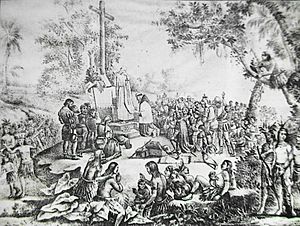Villa de Santa María de la Victoria facts for kids
The Villa de Santa María de la Victoria was an important early Spanish town. It was built in what is now the Mexican state of Tabasco. This town no longer exists today. It was built on the site of the ancient Maya city of Potonchán. Potonchán was the capital of the kingdom ruled by Tabscoob.
The Villa de Santa María de la Victoria was founded on March 25, 1519. It was established by Hernán Cortés himself. This happened after he won a battle against the local people, known as the Battle of Centla. This settlement was the very first Spanish town in what later became Mexico.
Over time, the town faced many challenges. Pirates attacked it often for more than 100 years. Also, the colonial government did not pay much attention to the area. Because of this, people started leaving the town around 1557. They moved to safer places away from the pirate raids. This led Spanish leaders to create a new town called San Juan Bautista. This new town, founded on June 24, 1564, is known today as Villahermosa. The final end for Santa María de la Victoria came in 1641. The Viceroy (a high-ranking official) Diego López Pacheco allowed the main powers of the Tabasco province to move. They moved from Santa María de la Victoria to San Juan Bautista. Slowly, the last people left the old village.
Founding the First Spanish Settlement
After a battle, Cortés met with the chief Tabscoob and other local leaders. They told him about a large city called Culúa. They said this city had a lot of gold. Cortés decided to travel to this new place.
But first, on March 25, 1519, he founded the village of Santa María de la Victoria. This was the first Spanish settlement in the area called New Spain. It was built right on top of the Maya town of Potonchán. Cortés named it to remember the battle fought on Lady Day. He ordered an altar to be built there. He also left an image of the Virgin Mary. In the village of Cintla or Centla, he built a wooden cross from a ceiba tree. This cross was placed in the center of the town square.
"... And with this, the conversation stopped until the next day. Then, the holy image of Our Lady and the cross, which we all worship, were placed on the altar. The priest Fray Bartolome de Olmedo held Mass. All the chiefs and important people were present. Cortés then gave the name Santa María de la Victoria to that place. And that is what the town of Potonchán or Tabasco is now called..."
—Bernal Díaz del Castillo, Historia Verdadera de la Conquista de la Nueva España (1519)
Later, on Palm Sunday, after another Mass, Cortés said goodbye to the local leaders. He then continued his journey. He left behind about 60 soldiers in the new village of Santa María de la Victoria. Their job was to bring peace to the region. After that, Cortés left for Culua (which is now San Juan de Ulúa, Veracruz). He was looking for the riches of the great empire "...from there, where the sun sets."
See also
 In Spanish: Villa de Santa María de la Victoria para niños
In Spanish: Villa de Santa María de la Victoria para niños


